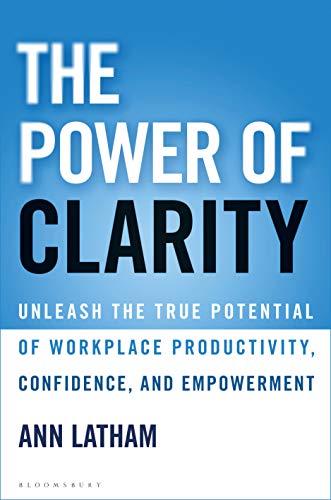The Power of Clarity
Unleash the True Potential of Workplace Productivity, Confidence and Empowerment


Ann Latham is the founder of the US-based consulting firm Uncommon Clarity – named after the term her former colleagues identified as her foremost commercial strength when she worked in large organisations. She has now worked with clients in over 40 industries including Boeing, Hitachi and PBS. She blogs for Forbes and is the author of The Clarity Papers and Uncommon Meetings.
When business was just trade, and trade was all about product it was pretty simple to work out what the product was, who had it and what more needed to be done to it to get it to the customer. In a world that has not just become service-driven, but also hugely virtual, it is far less straight-forward to identify and understand these things. What is more, is that most jobs, even in organisations that produce product, are now knowledge and service ones. The complexity of modern organisations further complicates the picture. If you recognise the issue of ‘where is this project right now?’ ‘who is it that needs to take the next step?’ ‘have all the right people put-in their ideas?’ … and more fundamentally ‘why are we doing this?’, then a dose of clarity is probably needed.
As Latham says: “welcome to the cognitive zone. this is where employees spend their days trying to move cognitive objects without the advantages of physical processes that move physical objects…”
The initial problem Latham shines a light on is ‘clarity blindness’ – our inability to see where we are being unclear. From her coaching she brings a multitude of examples of how lack of clarity manifests itself. It is usually from something seemingly inocuous and very familiar. Vague requests lie at the root of many of these instances: ‘please review’ rather than ‘is this approved?’, the former requires the recipient to feedback opinion and suggestions which is time-consuming, the latter demands a simple yes or no. To remove your clarity blindness Latham requires you to be able to spot ‘treadmill verbs’ – those requests that get you to no destination, but merely invite you to talk without purpose: report, update, communicate, discuss are others. We recognise all these elements as lying at the heart of meetings, another great consumer of working time often with little purpose. Meetings can generate ideas and discussion and be considered ‘good’ for that reason, but still not progress anything towards required outcomes and objectives. Meetings are rescued with ‘action points’ and ‘to do’ lists, which generate multiple priorities – further obscuring clarity and adding confusion.
Part of Latham’s solution is to move away from alternative-centric decision-making to objective-centric ones, that is not just randomly exploring other ways to do things, but to focus in on the way to do things to meet your specific objectives. It is all part of being more precise in the questions we ask of ourselves and others. Where do you start to answer the question ‘how are things going?’ when you run a multiplicity of different elements and tasks?
The problem is that measuring clarity is fuzzy, there are no metrics to benchmark it by. What Latham shows is that at the lower levels of any organisation clarity is usually at its highest, where the product or service is manufactured or delivered, the further into middle management you get the less clarity exists, and the more disclarity abounds. The curve improves a bit in senior management, possibly because they are clearer by nature, which has propelled them to senior management, more likely because their authority and ability to make strategic pronouncements without having to implement them themselves allows for greater clarity. The greater the distance between the CEO and production / customer-facing employees the greater the chances of and space to enable disclarity grows.
Latham offers three key steps to achieving clarity:
The manager’s number one responsibility is to create clarity – this frequently will require them to step back and select one of the first five overload options above – just not the last one.
Latham summarises her approach as Choose (with specificity), Start (the process), Focus (remove competing tasks and interruptions) and Finish (get it done, as well as it needs to be done).
In this engagingly written book, Latham shines her spotlight on some endemic failings that it would be astonishing if most readers did not recognise in themselves and their organisations. Many of the ‘clarity blindness’ activities she outlines are the outcomes of human interaction, a willingess to hear others out and the results of curious minds being tempted down irrelevant rabbit holes. There is a tinge of FW Taylor in the specific, processed, focused approach and as with everything in this world, some balance is needed. Luckily Latham comes across as very human and balanced, so appreciates that sticking to this approach exclusively may not be 100% sustainable, but wandering into chaotic disclarity is not sustainable or fulfilling either.
Having a clear understanding of what Best Practice Clarity looks like, is a highly valuable and important tool to have at your disposal. Like all tools it needs practice to use effectively and skillfully – and like all tools there will be times when you think it might not be appropriate for the situation.
Title: The Power of Clarity
Author/s Name/s: Ann Latham
Publisher: Bloomsbury Business
ISBN: 978-1-472-98713-6
Publishing Date: July, 2021
Number of Pages: 252
Author Knowledge Rating: 1-5 (based on their years of experience, academic expertise in subject areas, and exposure to cross-functional thinking in the area)

















































































Readability: 1-5 score(1=dense and v academic; 5=frantic; page turner)




































































































Appropriate Length: (1=could have been written in 25% of the length;5=could have been longer)


















































































Core Idea Value: (1=nonsense (or entirely esoteric); 5=game-changer)



































































































